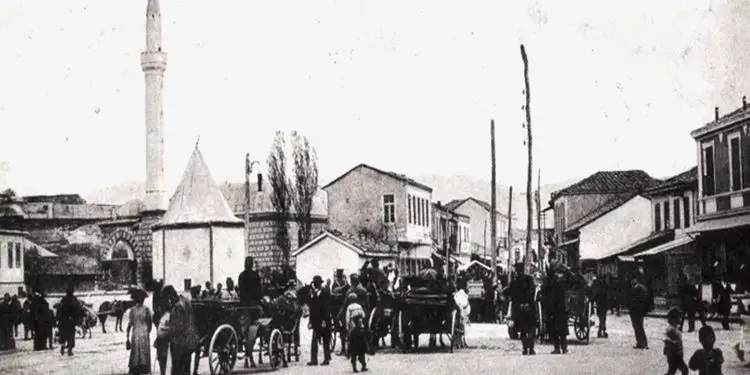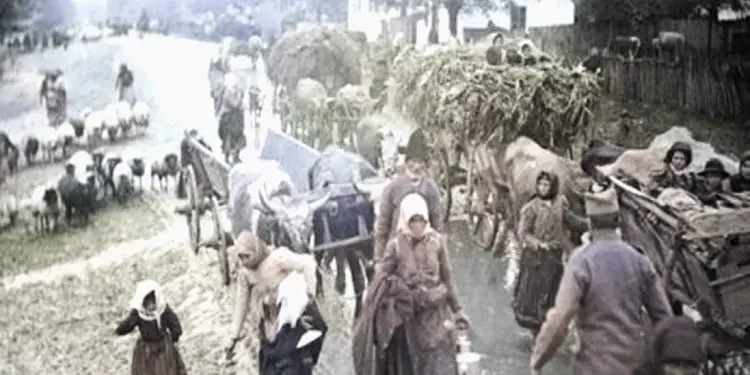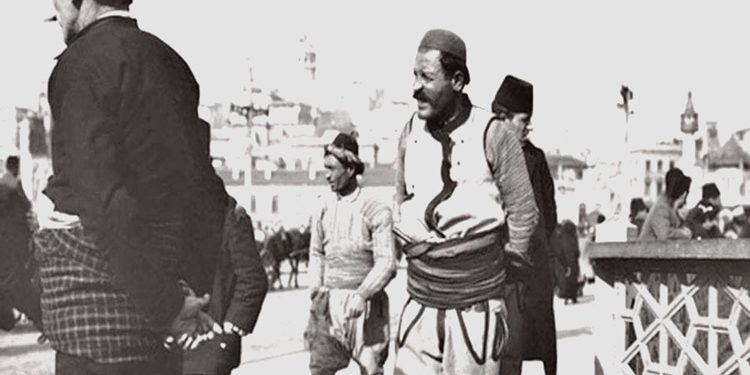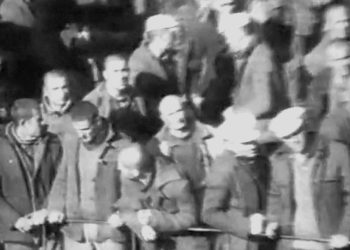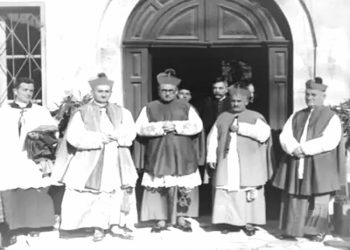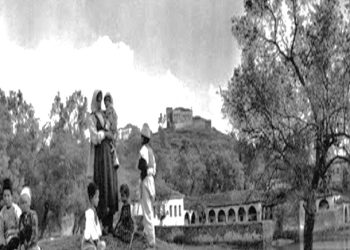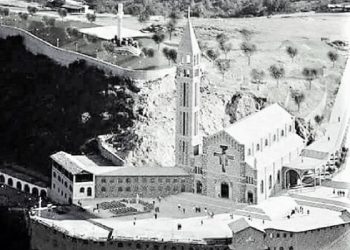By Qerim LITA
Part Two
– The relocation of Albanians in the years 1912-1939 and the reaction of the Albanian state –
With the outbreak of the First Balkan War, the withdrawal of the Ottoman Empire, and the occupation of Albanian lands by the Balkan Orthodox alliance, the process of displacement of the Albanian population from their ethnic lands to the Republic of Turkey resumed. Recently uncovered documents shed light on the fact that within the year 1912-‘13, the Serbian-Montenegrin and Greek occupying armies violently expelled over 200,000 Albanians, the vast majority of whom settled in Istanbul, Anatolia, and other regions of Turkey. Meanwhile, according to an estimate by the Albanian Legation in Ankara, in 1928 there were 27,000 to 30,000 Albanian families in Turkey, displaced from Kosovo, the Eastern territories, and Çameri, including those Albanians who had emigrated after 1913.
Continued from last issue
Consequently, during the month of August, the Ministry of Foreign Affairs prepared lists of hundreds of Albanian families, primarily from the regions of Skopje, Pollog, Peja, Mitrovica, Gjakova, Prishtina, Gjilan, and Monastir, who supposedly due to a “desire” to relocate to Turkey, had declared that they “voluntarily” wished to withdraw from the citizenship of Yugoslavia.
Meanwhile, Stojadinović’s government, in September 1935, established an Interministerial Committee, which in October of that year drafted a “Project” for, as stated: “the relocation of non-Slav elements from Southern Serbia.” Among other things, it stated that the issue of relocation “must be resolved as soon as possible through a special convention” between Yugoslavia and Turkey, as well as between Yugoslavia and Albania, just as “this issue was resolved between Turkey and Romania.”
In the event that an agreement with Albania could not be reached, it continued: “if an agreement cannot be reached for the relocation of Albanians in Albania, or if Albanians do not wish to relocate to Turkey, immediate recourse must be made to the existing legal provisions for the relocation of this element from the border areas to the interior of the country and the populating of the same areas with populations of Yugoslav nationality…!” The project for all those individuals who “expressed a desire to relocate,” respectively, declared that they withdrew from Yugoslav citizenship, provided for numerous facilitations.
This project was reviewed at the next Intermenstrual Conference, held on October 1, 1935, at the Ministry of Foreign Affairs in Belgrade, which included two representatives from the Ministry of Foreign Affairs, the Ministry of Agriculture, the General Staff, the Ministry of Finance, and the Ministry of Internal Affairs. The conference, after reviewing the project drafted by the “Narrow Committee,” brought forward conclusions, which we will present in full below:
- The issue of relocation must be resolved as soon as possible through a special convention between our state and Turkey, as well as between our state and Albania, in the same way it has been arranged between Turkey and Romania.
- In the event that an agreement cannot be signed with Albania for the relocation of Albanians in Albania, or if the Albanians (our citizens) do not wish to relocate to Turkey, it should be:
a) Gradually and according to a plan, within a long period of years, to proceed according to the existing legal provisions for the relocation of the population of Albanian and Turkish descent from the border areas to the interior, and to populate the same areas with populations of Yugoslav nationality;
b) Efforts should be made to achieve the exchange of populations, taking into account our element in the areas of Korça and Gollobordë, and the Albanians of these regions.
- All those persons who, based on Article 55 of the Citizenship Law, declare that they withdraw from our citizenship and will relocate for a specified period, should be provided with these facilitations:
a) They should be given free passports for relocation, collectively according to circumstances;
b) They should be exempted from all state debts: land taxes, other state taxes, army contributions, etc.;
c) In the event that relocating individuals have bank or private debts by September 1, 1935, farmers/applicants will be paid from the amount obtained from the sale of their real estate;
ç) A 75% exemption should be granted for railway transportation for individuals who are financially secure or have sold their property;
d) They should be allowed free travel to Thessaloniki or Svilengrad if they declare that they donate their real estate to our state. The same applies to those relocating with poor economic status;
dh) They should be exempted from all taxes for the transfer of movable property and money;
e) From the moment of declaring relocation, they should be exempted from: recruitment, military service, calls for training, and obtaining transportation means for training and maneuver purposes. An exception can be made if the relocation is not completed within one year from the date of the declaration.
- For a successful and swift relocation of this non-Slav element to Turkey or Albania, the conference sees it necessary to undertake the following measures:
a) By all means, overturn and prevent the propaganda being conducted by Albania among this element against the relocation;
b) From the non-Slav population planned for relocation, compliance with all legal provisions should be demanded, particularly those related to fiscal payments: land tax, military tax, etc.;
c) In the territory of Southern Serbia (Kosovo – Q.L.), especially in border areas, as often as possible, conscripts from the non-Slav background should be called for military training, either for training or maneuvering, or for the construction of strategic roads or fortified structures;
c) As a principle, individuals who are planned for relocation should not be accepted into state or self-governing services, while those who are already in state or self-governing services should be assigned to areas where our Slavic population resides;
d) The principle of compulsory education for the children of these areas in our primary schools should be rigorously implemented;
dh) All principles for the population of southern regions should be strictly adhered to, particularly in defining the necessary complexes for settlement, primarily in border areas;
e) The nationalization of the names of geographic features (settlements, rivers, mountains, etc.) and surnames of individuals should commence immediately. This also includes public signage, company names, advertisements, etc.;
ë) The aforementioned measures should be implemented immediately, starting from the border line with Albania into the interior of the country.
- The conference is of the opinion that the implementation of these measures, along with the entire plan, should be entrusted to a permanent committee established by professional individuals (from the Ministry of Agriculture, the Ministry of Finance, the Ministry of Communications, the Ministry of the Army and Navy, the Ministry of Internal Affairs, and the Ministry of Foreign Affairs), who would be given specific powers and would have the necessary material resources at their disposal.
Immediately after this, the Ministry of Foreign Affairs ordered its Legation in Ankara to initiate as quickly as possible the reaching of a convention with the Government of the Republic of Turkey for “the relocation of the Muslim population from the southern regions to Turkey.” This issue, it was stated in the order, “is of paramount importance for our country,” therefore, it should “be given the utmost attention” and efforts should be made to “reach the proposed agreement with the Turkish government as soon as possible…!”
Preliminarily, the Yugoslav Prime Minister, Milan Stojadinović, complained through a letter to his delegate in Ankara, Branko Llazarević, that “all efforts for the assimilation” of the Albanian population had failed because the “Orthodox population” in Kosovo and in other Albanian regions was “very few in percentage,” and besides this, was not well-prepared for assimilation. The only remaining option was the “mass relocation of the non-Slav population” from the Yugoslav borders, which could be achieved “through a special plan.”
Despite the numerous efforts of the political, diplomatic, police, and military circles in Yugoslavia, the process of relocation did not proceed as they had planned. Furthermore, the official Belgrade failed to persuade Ankara to sign the convention so desired by Serbian circles, with which they hoped to ultimately expel all Albanians from Kosovo and other areas under their occupation.
However, this issue was not a priority for the Turkish government authorities because, according to them, the number of the Turkish population in this (Yugoslav) state was around 50,000 inhabitants, which, compared to other Balkan states, such as Bulgaria (with a population of 400,000), Greece (300,000), and Romania (450,000), constituted an insignificant minority. Although this data was real, it contradicted the plans and projects of Greater Serbia, which envisioned the relocation of about 750,000 Muslims (considering 550,000 as Albanians and 200,000 as Turks) from the Albanian lands that were annexed to Serbia in 1913.
After nearly three years of efforts, the Yugoslav authorities, taking advantage of the Balkan Agreement Conference held in February 1938 in Ankara, finally managed to persuade the Turkish government to commence negotiations regarding the convention. The Yugoslav Prime Minister, M. Stojadinović, on March 29, 1938, via an encrypted telegram, instructed his delegate in Ankara, Axhemović, to act with Turkish authorities regarding the acceleration of the start of negotiations for the relocation of the Albanian population to Turkey.
Meanwhile, the Turkish authorities proposed that the negotiations begin on June 7, 1938, in Istanbul, which the Yugoslav party agreed to. In fact, the negotiations began on June 9 and lasted until July 11. The Turkish delegation was represented by Hasan Saka, a member of parliament and former minister, while the Yugoslav delegation consisted of: Milan Ristić, head of the Political Department at the Ministry of Foreign Affairs, and Vojisav Magovčević, an inspector at the Ministry of Agriculture. A Romanian delegate and a Greek supervisor were also supposed to participate in the negotiations. The head of the Yugoslav delegation, M. Ristić, wrote to M. Stojadinović on June 14, 1938, regarding the course of the negotiations, in which he stated that the Turks had agreed on two essential issues:
1/ Within a period of six years, they would accept 200,000 individuals from Southern Serbia (Kosovo and Albanian territories in Macedonia and Montenegro). Children under the age of 10 would not be included in this quota, nor would compensation be given for them; and
2/ That this quota would also include Albanians.
The negotiations, as mentioned above, lasted until July 11, on which date both negotiating parties signed the final text of the Convention. At the meeting, it was decided to prepare a communiqué that would be sent to the press of both countries, under the auspices of the Anadolu Agency, which we present below in full:
“The Relocation Commission established to study and examine issues concerning the relocation of Turks from Yugoslavia convened on June 9, 1938, in Istanbul, under the leadership of H. T. Hasan Saka, a deputy and chairman of the Turkish Section of the Balkan Economic Cooperation Council, and concluded its work on July 11, 1938, bringing a positive and satisfactory result for the interested parties of both friendly and allied countries.
This Commission consisted of: Mr. Hasan Saka; Xhevdet Atasagan, General Director for Population Settlement at the Ministry of Hygiene and Social Assistance; Milan A. Ristić, Head of the Balkan Section at the Ministry of Foreign Affairs of Yugoslavia; and Vojslav V. Magovčević, an inspector at the Ministry of Agriculture. The delegates signed the text of the Convention that governs and regulates the relocation of Turks from Yugoslavia, which will subsequently be presented to their respective governments. This Convention will be signed as soon as the respective governments approve it and will enter into force upon ratification.”
The Convention stipulated that within six years, starting from 1939 to 1944, a total of 40,000 Muslim Albanian families would be relocated from Kosovo, the Albanian territories in North Macedonia, and Montenegro. This issue was clarified in Article IV of the Convention, which expressly stated:
“The repatriation of these 40,000 families will take place within a period of six years, with the following allocations:
In 1939: 4,000 families
In 1940: 6,000 families
In 1941: 7,000 families
In 1942: 7,000 families
In 1943: 8,000 families
In 1944: 8,000 families
If this annual quota cannot be realized due to any unforeseen circumstances, both contracting parties will agree through their respective legations on the number of displaced persons to be evacuated or received on one side and the other, three months prior to the start of the relocation period. Meanwhile, it is understood that these unforeseen adjustments to the annual number of relocated persons cannot extend beyond one year of the specified six-month relocation deadline. The annual relocation periods will last from the beginning of May until October 15, except when it comes to the contingent of dislocated persons for the first year, which will begin to be evacuated only at the start of July 1939.”
For every relocating family, Yugoslavia was obligated to pay Turkey 500 Turkish lira, while all the real estate of the displaced persons would transfer to the ownership of the Yugoslav state. For the Convention to become fully effective, its legalization and ratification were necessary; however, the negotiating parties, citing “political reasons,” did not recommend a regular procedure for legalization. According to them, it would be better for the “Convention to come into effect through regulation and then to be legalized through the upcoming financial law.”
Article II of the Convention defined the regions subject to relocation, which were as follows:
1) The districts of the Vardar Banovina, such as:
From Mali Sharr (Prizren), from Gora (Dragash), from Podgurra (Suhareka), from Nerodimja (Ferizaj), from Lower Pollog (Tetova), from Upper Pollog (Gostivar), from Galica (Radastush), from Dibra (Dibra), from Struga (Struga), from Graçanica (Prishtina), from Kaçanik (Kaçanik), from Gjilan (Gjilan), from Presheva (Presheva), from Prespa (Resnja), from Ohrid (Ohrid), from Kërçova (Kërçova), from Krusheva (Krusheva), from Poreçi (Brodi i Jugut), from Prilepi (Prilep), from Manastiri (Manastir), from Kavadari (Kavadar), from Marihova (Manastiri), from Negotini above Vardar (Negotini above Vardar), from Shkupi (Shkup), from Kumanova (Kumanova), from Velesi (Veles), from Ovçe Pole (Sveti Nikolla), from Shtipi (Shtip), from Koçani (Koçani), from Radovishi (Radovish), from Strumica (Strumica), from Dojrani (Vallandovë), from Gjevgjelia (Gjevgjelie), from Kriva Pallanka (Kriva Pallanka), from Kratova (Kratovë), from Carevo Sello (Carevo Sella), from Malesheva (Berovë);
2) The districts of the Zeta Banovina, specifically:
From Peja (Peja), from Istogu (Istog), from Mitrovica e Kosovës (Mitrovica), from Gjakova (Gjakovë), from Podrimja (Rahovec);
3) The districts of the Morava Banovina, such as:
From Llabi (Podujevë), from Vuçitërna (Vuçitërna), from Drenica (Skenderaj).
The Yugoslav government would determine itself in which regions the relocation would initially begin./Memorie.al
To be continued in the next issue.




